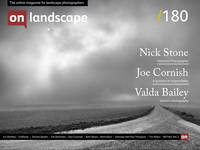Does being an outdoor photographer inevitably lead to environmentalism?
Do we have a Voice? And does being an outdoor photographer inevitably lead to environmentalism? And if so, what if anything are our responsibilities?
I had better begin with a declaration. I am an environmentalist and have been all my adult life. But – regrettably – not in an activist sense. Yes, I’ve been on a couple of marches, and occasionally written to my MP. But compared with friends and contemporaries who have dedicated their lives fighting for the causes of wildlife and the environment, my active contribution has been minimal.
Claiming no moral authority, and with only a superficial scientific understanding of the issues, I have contented myself with minimising my environmental impact in daily life. I willingly admit to being led by my partner Jenny who has pioneered most of our pro-environmental behaviour. It is she who organised thermal water panels and photovoltaics on our roof, the water butts and grey water for gardening. It is she who grows enough food (organically) in that garden to feed us for six months of the year. And it is she who makes sure we wear thermal underwear, hats and gloves in the house during winter, and only use the central heating when we have guests. Jen is the committed vegetarian, I am the reluctant follower. Jen has always aimed to tread lightly on the earth, and it has been my good fortune to live with someone who has helped me stay close to values which would otherwise be a distant aspiration only.
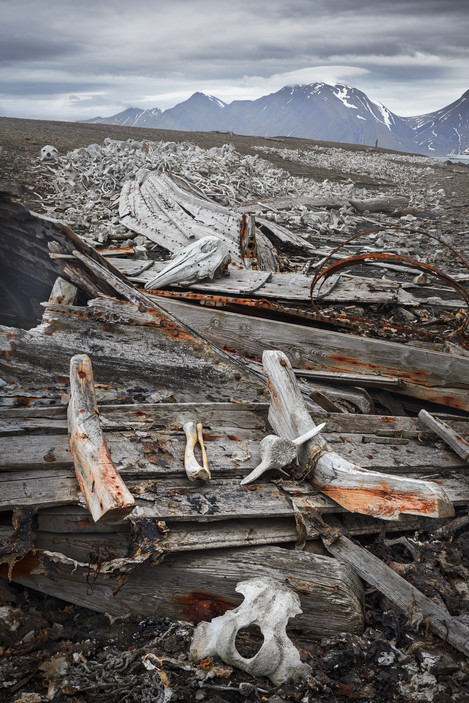
Beluga charnel, Bourbonhamna
This haunting place in Svalbard is scattered with hundreds of thousands of whale bones, tragic remains of the now almost-passed whaling industry. Largely confined to Arctic and Antarctic waters, and so out of sight from public gaze, the slaughter of whales continued unchecked until 1985.
However, this relatively virtuous home life is spoiled by work. To earn a living, travel remains unavoidable, along with its inevitable carbon footprint. There might be as many as a dozen flights a year (some intercontinental); and often upward of 20,000 miles of driving, in a diesel car, since like so many we were convinced by the lower CO2 argument to buy diesel back in the late 2000s.
The World is a book, and those who do not travel read only one page. ~St Augustine
I used to be reasonably secure that at least some of my travel was justified. Travel has taught me about places and habitats; has been an illuminating, life-enriching experience. Creatively, in addition to all the amazing sights, travel brings journey time when, in planes and trains especially, there is time to anticipate, reflect, imagine and dream. I have contributed a little bit to local economies and developed an understanding of, empathy for, and solidarity with people in other parts of the world. I have made a living doing something I love, and when the children lived at home, still managed to feed my young family.
In contrast to hardcore photojournalists (who I greatly admire), I believed that as well as images of pollution, disaster and suffering it was essential to make pictures that conveyed beauty and inspiration; that gave meaning to what we might lose if we failed to protect our planetary home. If our job as photographers was to tell stories from the front line, I felt adapted to telling the stories of what seemed right, that lifted the spirits. My professional work for the National Trust, Woodland Trust and Wildlife Trusts helped me feel I was part of a positive environmental message, of care, and hope.
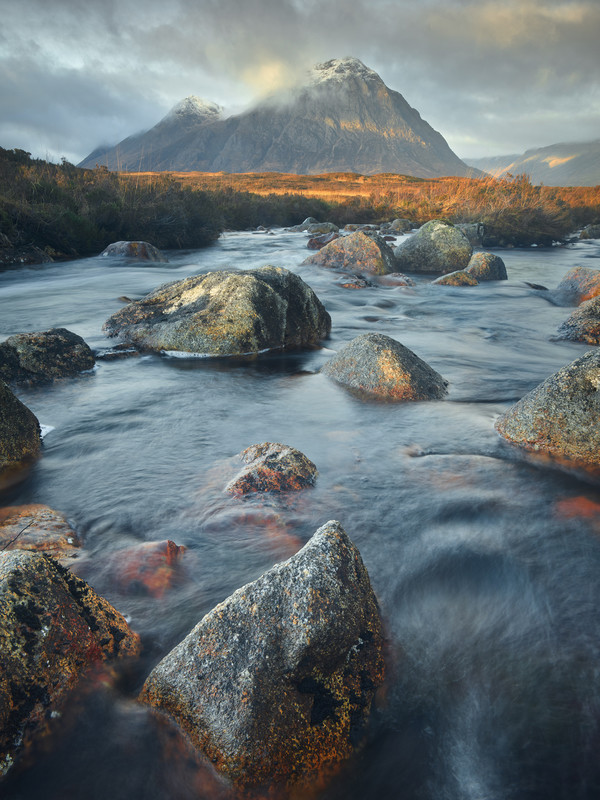
Buachaille Etive Mor, winter
While some winters can still produce impressive snowfalls in the UK, everyone of a certain age remembers the winters of childhood as colder, and records bear this out. The trend to milder temperatures travels in a bumpy, unpredictable fashion, but the underlying direction is upward, corroborating theoretical modelling with increased atmospheric carbon concentrations.
Fortunately, Scotland is still beautiful in almost all conditions. This image was made in January this year.
Underneath the particular image in question, the particular short story or musical composition, we're looking for a source of hope. ~ Barry Lopez
Paradise Lost
That industrialising resource exploitation (mining, fishing, farming etc), felling virgin forest and unchecked urban sprawl degrades, devastates and pollutes ecosystems has been known almost since it began. These threats did not originate in the 21st century, and many of them precede the 20th, forged in the crucible of the industrial revolution. In the arts, late-18th and early-19th century Romanticism was in large part a reaction against industrialisation. Yet in a century brutalised and distracted by World Wars, 20th century Modernism embraced and celebrated the advances of modernity, technology and urbanisation.
However, the confidence that Modernism had in technological progress has dissolved in the last few decades, increasingly replaced by fear and alarm at the destruction that this progress is inflicting on the world.
Many writers and thinkers have highlighted our negligence and unsustainable exploitation of resources for many decades, Aldo Leopold, Rachel Carson and James Lovelock all spring to mind. It was James Lovelock’s Gaia Theory, which I read as a student in the late-1970s that shaped my perspective on our developing environmental crisis. Especially with regard to climate change.
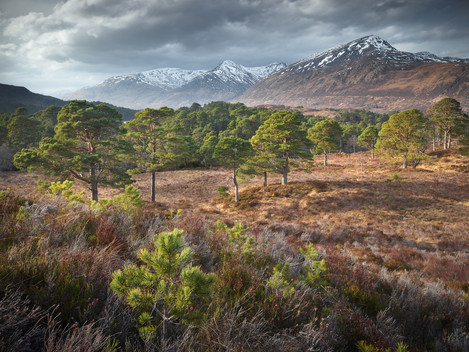
Caledonian pines, Glen Affric
If protected from hungry deer, seedlings become saplings become trees, and it’s almost impossible not to see the recovery of a forest as a hopeful sign. Ultimately, large ruminants are also part of our world, a key component in earth’s evolution, and in all probability companions to our ancestors as they occupied post-Ice Age Britain. Therefore it’s likely that landscape was not all closed-canopy forest, but included a range of other habitats, including marsh, grazed meadows, heath, open moor and relatively bare mountains, a diversity that can still be found in Alaska and other northern hemisphere wilderness.
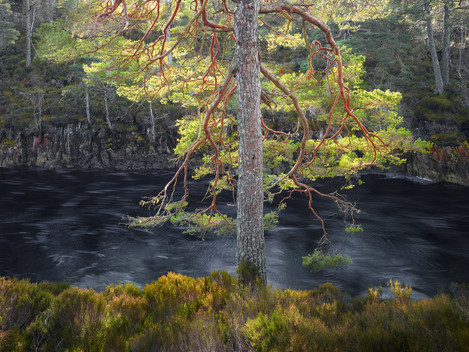
Caledonian pine, River Affric
Scotland is becoming a world leader in rewilding, and habitat rejuvenation. Its wildland is already wonderfully rich in biodiversity compared with the impoverished state of many parts of our British Isles, although the unbalanced, top-predator-free imbalance remains. Places being carefully managed for the future are silver linings of hope.
In 1993 Jenny and I moved to North Yorkshire. Jen, in particular, did not want to bring up our young children in the polluted air of London. The first consideration when looking for a house was that we didn’t want a low, coastal location (due to melting ice caps and rising sea levels); and we wanted a home that wasn’t built on a flood plain. We might have been a bit too far ahead of our time for the former worry, but the latter has proved prescient. The point is, climate change was already common knowledge, part of our conversation. We knew it was coming.
In the last years and months, the amount of new data coming forward on the destruction of the eco-system fabric which maintains the web of life across the planet has gained pace. Coral reef bleaching and decay. Insect population collapse. Many species reaching the brink of viability. Mostly these crises are the result of habitat loss and climate change. Whether motivated by survival, consumption, development or pure greed, these crises are anthropogenically caused.
Stepping back from the apocalyptic brink for a moment, there are also positive stories. Following the IWC’s 1982 commercial whaling moratorium, some whale populations are rebounding from the near-extinction to which they were subjected. We tackled the hole in the ozone layer (with the Montreal Protocol) and that situation is now greatly improved. The Antarctic Treaty protects Antarctica from any commercial or industrial resource exploitation, especially for fossil fuels. These examples show that with goodwill, people can work together, internationally, for the common good. In the UK, otter numbers are increasing in rivers from which they had once disappeared, and beavers are slowly being re-introduced.
But the hopeful stories are, currently, hugely outweighed by the gloomy ones.
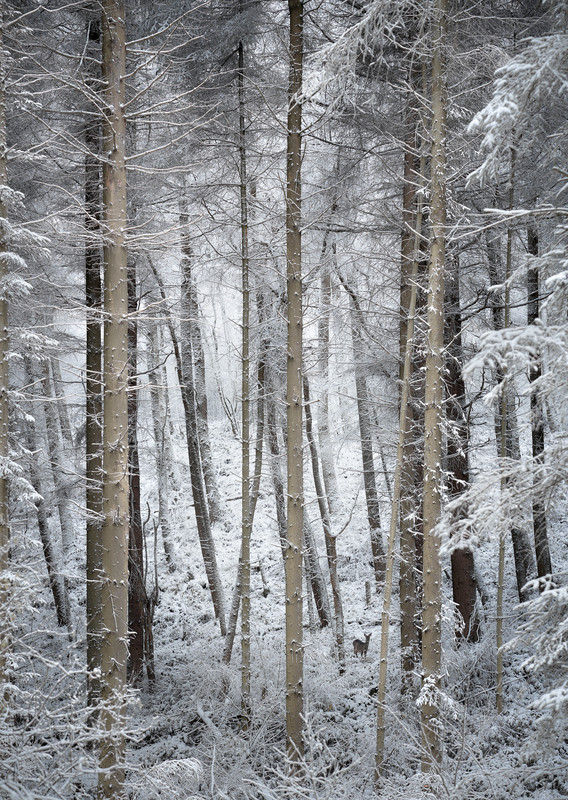
Deer, Gribdale woods, winter
This is a mature plantation above our village in North Yorkshire. It was a thrill to see this roe deer, as the numbers are fairly small and transient in the area. Since the picture was taken almost all the trees have been felled, and although this is the inevitable destiny of plantation trees I was surprised to find how much I miss them, even the non-native sitka spruce.
The term, Shifting Baseline Syndrome, goes a long way to explaining how we normalise whatever we see around us, and so in a world depleted of vast numbers of mighty creatures, we see our impoverished landscapes as normal. Once, humans were but one of many animals who shared this planet, in some form of reasonably dynamic balance. Natural catastrophes and cycles would occur, including climatic ones such as Ice Ages, and life re-formed around niches that were sometimes radically altered to what had been before. But never was the catastrophe a direct result of one willful species.
Farmers frequently pronounce themselves the guardians of our cherished land, the ones who protect and enhance its beauty. There is no merit in blaming farmers for the industrialisation of agriculture brought about by the post-war drive for ever-cheaper food (at any environmental cost). Their practice simply reflected the political, technological and cultural imperatives that prevailed then. Yet this perspective strikes me as a perfect example of shifting baseline syndrome. To our generations landscape still appears beautiful, electricity pylons, motorways and so on notwithstanding; it’s what we know, and represents open space, a superficial appearance of nature, and a welcome relief from the crushing ugliness of so much of our urban environment. But to believe that the modern agricultural landscape of much of the UK is somehow a rural idyll maintained by the benign offices of 21st century farming sets the bar of expectation and beauty extraordinarily low. Especially if we use bio-diversity as a measure.
In Sapiens, Yuval Noah Harari points out that across planet Earth the domestic animals we breed for meat (and other services), cows, pigs, sheep and chickens predominantly, weigh around 700 million tons. ALL other large animals (from porcupines and penguins to elephants, walruses and whales) living in the wild weigh less than 100 million tons. It’s important to point out that this figure does not include small animals, insects, bacteria, plants, trees etc which make up a much larger proportion of the earth’s biomass. Nevertheless, that our domestic animal stocks outnumber similarly-sized wild ones by a factor of at least 7x is a shock, particularly when you consider that not so long ago those proportions would have been reversed.
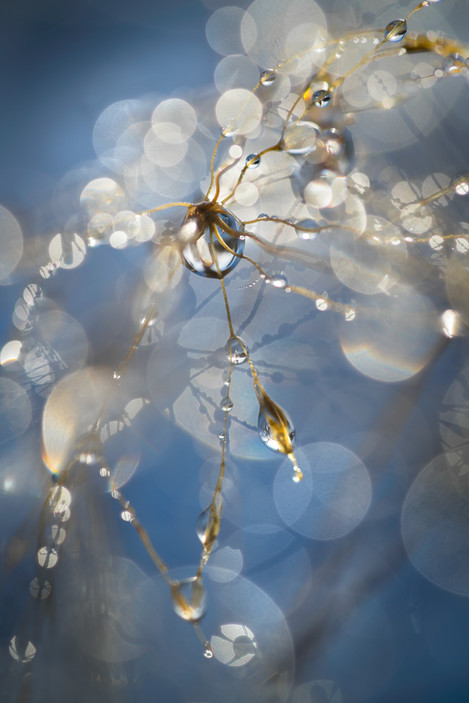
Dewdrop galaxy
Fortunately, as outdoor photographers we don’t have to travel halfway around the world to enjoy our photography. This picture was made about a mile outside our village one winter morning. A macro lens encourages us to look closer, opening new worlds of visual delight in nature.
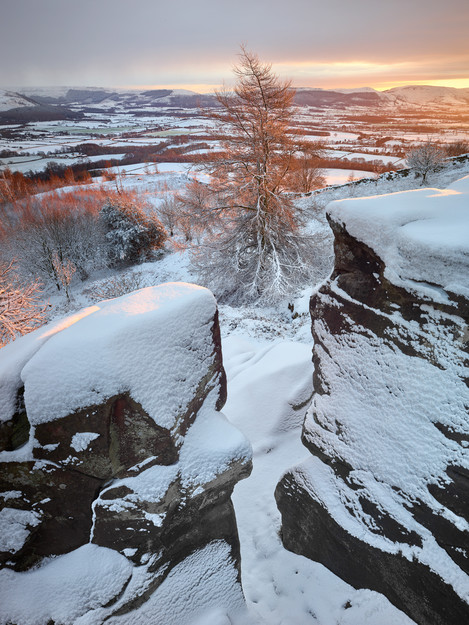
Easby Moor view, winter
I have stood here countless times, admiring the view as it is on a favourite local walk. The dark flanks of the crags make it a tricky aesthetic puzzle, but the snow solved that problem one day this January. It is the only significant snow day we have had in our area this winter.
While they may disrupt the recovery of woodland in Scotland, spotting a deer in an English forest is quite a thrill. But imagine how many more of them there would have been 500 years ago, not to mention any number of other animals who would have made that forest home. Since then we eliminated top predators (bear, wolf, lynx) in the British Isles, and to manage the numbers of wild ruminants that remain (deer primarily) we have to hunt them, substituting natural predation. We also wage war on remaining wild creatures, seeking to exterminate those with which we have a long-held enmity (rats, mice, foxes) and blaming the badger for infecting cows with bovine TB. Lacking serious predators to control them there are still plenty of rabbits and grey squirrels, but bird numbers throughout our islands are in a long term pattern of decline. And this in a country of committed bird-watchers and wildlife enthusiasts.
Some older folk recall woods and countryside rich in bird-song, and the butterfly-filled meadows of their childhoods. And winters where the snow lay so deep they had to walk along the tops of hedges beside the road to get to school! Admittedly, weather is weather, and we certainly still get cold snaps. But the temperature trend is relentlessly upwards, and those of us who have been photographing the outdoors for decades can feel and see those changes.
For me personally, encounters with true wilderness are the highlight of my life, certainly as a photographer and story-teller. These experiences are often restorative, redemptive and fill me with hope. It’s funny how often that many people I travel with, especially to the polar regions, come to see wilderness as the Real World. To bear witness to mighty (and microscopic) animals moving around on land and in the ocean, still acting out the immutable rhythms, patterns and laws of life according to the choreography of evolution is majestic, and life changing.
The thought that we are exterminating the extraordinary beauty and deeper reality of the wild world is a dagger to the heart. Yet compared with rising sea-levels, floods, drought, famine, displacement and the suffering that will follow, aesthetic and inspirational decline may be the least of our worries.
We’re All Doomed. ~ Private Fraser, Dad’s Army
The Moral Maze
There are arguments that as our technology develops, once we trash planet Earth we can simply board spacecraft and ride off in search of planetary pastures new. Inconveniently, reality suggests otherwise. Perhaps this 2001 A Space Odyssey-style fantasy has finally bitten the dust for I’ve not heard it expressed in a while. Pioneering astrophysics has now revealed the certainty that many stars have planetary systems, yet it is also true that in the foreseeable future there is no planet B.
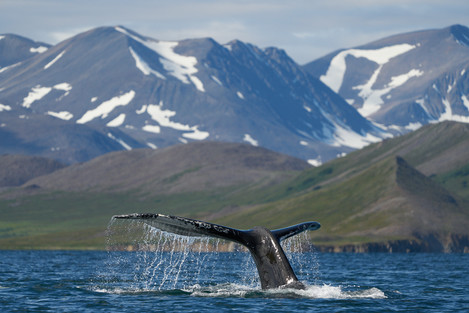
Humpback whale tail, Chukotka East of Siberia, Chukotka is the true Russian Far East. Just south of the Arctic circle this part resembles Scotland in its landforms, but with virtually no people. It’s no great surprise to discover sizeable schools of humpback whale here in the summer, a species which has thrived since the Whaling Moratorium of 1985. Watching humpbacks is an extraordinary thrill; their breaching behaviour being one of the wonders of nature.
For Jen and I, those afore-mentioned young children are now young adults, a journalist and a scientist. Their insight, courage and wisdom has forced me to reconsider many of my previously-held beliefs, although on environmental matters we are as one. But parents or not, as eyewitnesses to the world around us we photographers have an opportunity, maybe even a responsibility, to say it as it is.
Following the lead of teenage Swedish Climate Change activist, Greta Thunberg, children around the world have taken time off their lessons to protest the lack of action on climate change. They have been widely chastised by adults and politicians, especially in the UK. I heard one middle-aged gentleman on a radio phone-in saying ‘Save us from the sanctimonious opinions of children’. Funny how young people are constantly under attack for being politically apathetic, and then the moment they actually get out and do something they are criticised for being sanctimonious.
In short, why would children NOT care about their future? Should we really expect them to stick their heads in the sand and carry on, business as usual, as we have done? Our hypocrisy is surpassed only by our complacency. On their own children may not change the world. But in a few years, they will no longer be children and the awareness and concern they are developing now suggest there is hope that they will accelerate change in a way that our generation has not. I may be too optimistic but I find their passion and commitment an inspiration.
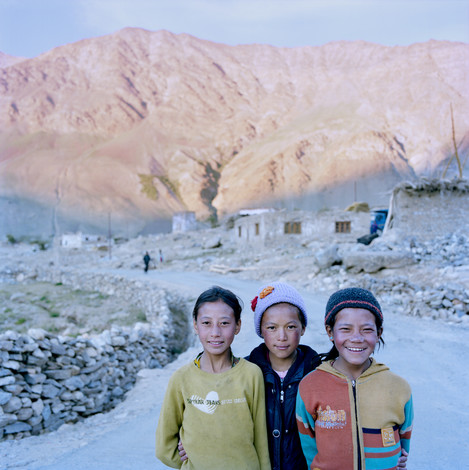
Growing up in Ladakh
As I set up my tripod and Hasselblad in this mountain village some years ago, these youngsters came to inspect their strange European visitor (me) and insisted on having their portraits taken. How could I refuse? The road is a new arrival and will inevitably lead to changes in their traditional way of life. The march of progress is not all benign, but should at least mean better medical services and hopefully a healthier old age.
Call to Arms
In the past I’d never be one to stick my head above the parapet, and basically, I am still that person. I’d love to hide behind my work, believe that the search for meaning and beauty is enough, and hope that people who enjoy my pictures draw their own conclusions that the natural world, the wild world really does matter. Maybe as a young photographer, I wasn’t angry enough to play the activist role. But I am angry now…with myself for my foot-dragging, and with our species-wide willingness to ignore scientific evidence.
Times have changed, and to say and do nothing feels amoral, borderline unethical even. Especially as I will likely continue to travel, to photograph in places and habitats that inspire me. If I do that then I must strive to be less of the problem, more of the solution (whatever that might be). I have seriously considered NOT travelling at all, but that seems a decision to become a spectator only, or hermit.
But I must scrutinise my travels more critically, cut back where possible (especially on flights), use the train whenever practical, do carbon offset mitigation (eg tree-planting), and although we will keep the car going as long as we possibly can, when forced to change it will be electric. There’s no shortage of photographic opportunity in the garden; I have advocated focussing on my/your local landscapes in the past, for environmental and creative reasons, and I should follow my own advice more closely.
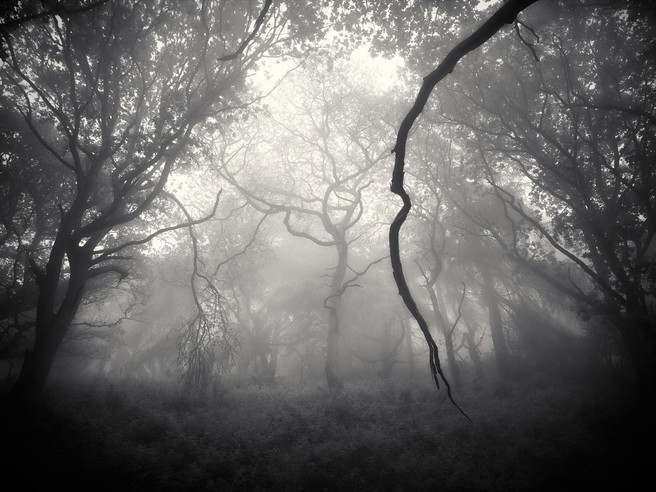
Newton Wood, mist
Working and walking locally I am familiar with almost every part of our local woods. Yet when the mist arrives it still leads to surprising transformations. Such conditions are a reminder to make images about something, and not just of something.
What about the photographic process itself? Although willing to try I doubt I can use much less electricity, but I do print and printing has its consumables of paper and ink.
We should probably also be rocking the foundations of the ivory towers in which our politicians seem to live until they hear loud and clear that the environment matters to us, and can see that our votes may be won with ecological policies. Secondly, if we have any money invested, think hard about where (it is invested) and whether it could be somewhere better for our planetary future. It might even perform better in the long run too because the young people who will be leading the world soon are going to favour those industries which are sustainable.
I may be the only person having these thoughts. But I doubt it. If any of this resonates for you, if you want to share your ideas or suggestions, or feel you could write or contribute a piece on what we as a community can do collectively to help the causes of landscape, ecosystems and the wild world then please do contact Tim (via the contact page), who is keen to spotlight what has become the issue of our time. And how we might use our photography to best highlight the importance of nature, with joy, irony, anger, sadness or humour…whatever that voice may be.
A world with wilderness depleted or devastated, and without hope would be a terrible legacy to leave our grand-children. Clearly alone none of us can do very much. But if we were able to co-ordinate our efforts and ideas then we might have a better chance of making some difference.
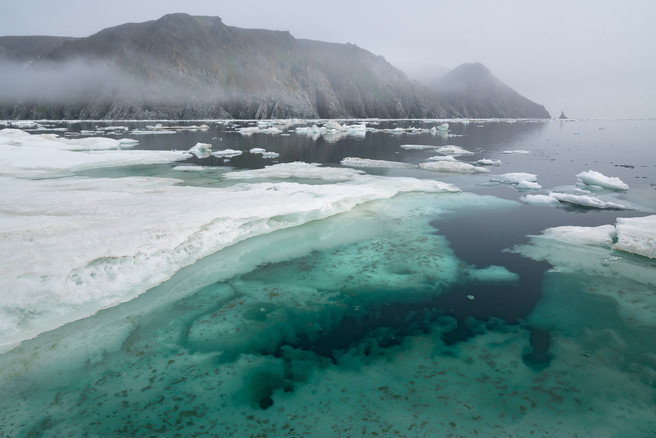
On thin ice, Wrangel Island
Being out in a small boat on the Arctic Ocean is a special travel experience, and to be able to walk on that ocean, on its sea ice, even more so. Sea Ice (pack ice) is in a state of long term decline, a trend scientists have charted for decades. As it reduces so it opens up possibilities for shipping, leading to disturbance and danger for the animals that live here. Mineral exploitation also becomes more likely, an enormous and inevitable pollution hazard. The decay of sea ice also means loss of albedo effect, so instead of being reflected by the whiteness of the ice, more sunlight is absorbed by dark open ocean water, accelerating the warming trend.
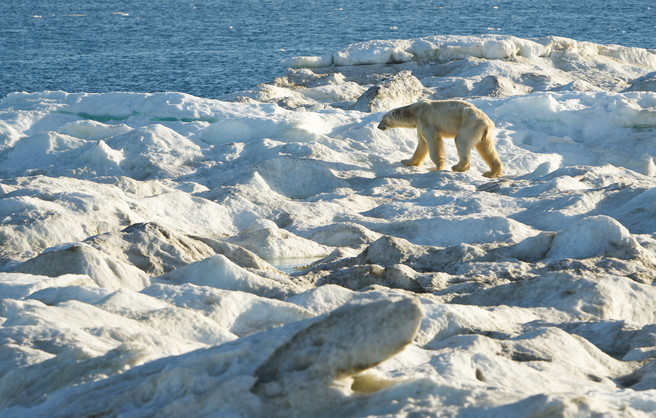
Polar bear in trouble, Wrangel island
Even polar bears get old and when they do they lose strength, hunting ability and eventually weaken and die. Here is an old bear probably in its last summer. It’s now probably too weak to make another kill and would only recover if it found carrion. Its individual predicament cannot be linked to climate change. Nevertheless, as the sea ice which is their primary hunting ground diminishes, so polar bears will find survival increasingly difficult.
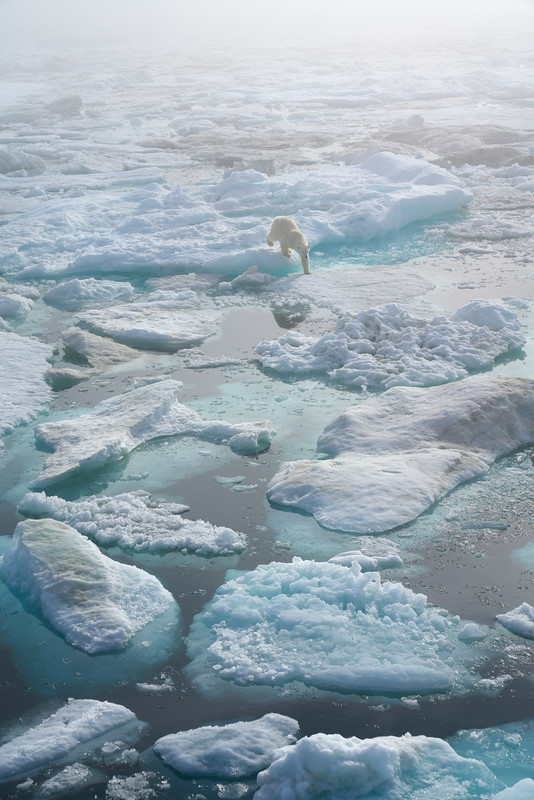
Polar bear on sea ice, Wrangel island
Patrolling the vast expanses of Arctic sea ice, a polar bear’s adaptation to this niche in the ecosystem is miraculous. To see them in their natural habitat, going about their lives as they have for hundreds of thousands of years puts ours into perspective.
The Third World War has already begun. Not on battlefields, or in the tactical plans of the military establishment. Rather it’s a political war of ideas and beliefs, for sustainable change against business-as-usual inertia, that will be waged perhaps for decades…unless and until we can secure wide-ranging international legally-enforced action to bear down on climate change and ecological destruction. Paris was a good start, but so much more needs doing, and doing much more quickly. Will it mean lifestyle changes? Yes, but a return to hunter-gathering is not a realistic direction; we will have to supercharge the development of new and sustainable technologies perhaps including carbon capture, enact a new revolution in food production, and reconsider the wisdom of an eternally consumption-based vision for economies.
Live simply, that others may simply live.~ Mahatma Gandi
In Gandhi's time, this advice addressed the burning inequalities that ran through human societies, and the economic gulf between the developed and developing worlds. Perhaps in our time, it is the animals and ecosystems of the wild world who are the “others”; we may not easily see it, but their future survival and prosperity is inextricably linked with our own.
Apathy, resignation and a feeling of impotence may be understandable. It’s so easy to believe and say that our individual lives, decisions, behaviour are insignificant, and make no difference in the grand scheme of things…who can argue with that? But that’s like saying we don’t matter and have no responsibility. It’s vital that we do not become despondent, and instead feel galvanised to rise to the challenges that lie ahead. As eyewitnesses to, and beneficiaries of, nature’s beauty and inspiration it would be good if we can play our part to defend it.
And it is by looking to one another, by attending to the responsibilities of maintaining good relations in whatever we do, that communities turn a gathering darkness into light. ~ Barry Lopez
- Beluga charnel, Bourbonhamna This haunting place in Svalbard is scattered with hundreds of thousands of whale bones, tragic remains of the now almost-passed whaling industry. Largely confined to Arctic and Antarctic waters, and so out of sight from public gaze, the slaughter of whales continued unchecked until 1985.
- Caledonian pines, Glen Affric If protected from hungry deer, seedlings become saplings become trees, and it’s almost impossible not to see the recovery of forest as a hopeful sign. Ultimately, large ruminants are also part of our world, a key component in earth’s evolution, and in all probability companions to our ancestors as they occupied post-Ice Age Britain. Therefore it’s likely that landscape was not all closed-canopy forest, but included a range of other habitats, including marsh, grazed meadows, heath, open moor and relatively bare mountains, a diversity that can still be found in Alaska and other northern hemisphere wilderness.
- Caledonian pine, River Affric Scotland is becoming a world leader in rewilding, and habitat rejuvenation. Its wild land is already wonderfully rich in biodiversity compared with the impoverished state of many parts of our British Isles, although the unbalanced, top-predator-free imbalance remains. Places being carefully managed for the future are silver linings of hope.
- Easby Moor view, winter I have stood here countless times, admiring the view as it is on a favourite local walk. The dark flanks of the crags make it a tricky aesthetic puzzle, but the snow solved that problem one day this January. It is the only significant snow day we have had in our area this winter.
- Buachaille Etive Mor, winter While some winters can still produce impressive snowfalls in the UK, everyone of a certain age remembers the winters of childhood as colder, and records bear this out. The trend to milder temperatures travels in a bumpy, unpredictable fashion, but the underlying direction is upward, corroborating theoretical modelling with increased atmospheric carbon concentrations. Fortunately, Scotland is still beautiful in almost all conditions. This images was made in January this year.
- Polar bear in trouble, Wrangel island Even polar bears get old and when they do they lose strength, hunting ability and eventually weaken and die. Here is an old bear probably in its last summer. It’s now probably too weak to make another kill and would only recover if it found carrion. Its individual predicament cannot be linked to climate change. Nevertheless, as the sea ice which is their primary hunting ground diminishes, so polar bears will find survival increasingly difficult.
- On thin ice, Wrangel Island Being out in a small boat on the Arctic Ocean is a special travel experience, and to be able to walk on that ocean, on its sea ice, even more so. Sea Ice (pack ice) is in a state of long term decline, a trend scientists have charted for decades. As it reduces so it opens up possibilities for shipping, leading to disturbance and danger for the animals that live here. Mineral exploitation also becomes more likely, an enormous and inevitable pollution hazard. The decay of sea ice also means loss of albedo effect, so instead of being reflected by the whiteness of the ice, more sunlight is absorbed by dark open ocean water, accelerating the warming trend.
- Newton Wood, mist Working and walking locally I am familiar with almost every part of our local woods. Yet when the mist arrives it still leads to surprising transformations. Such conditions are a reminder to make images about something, and not just of something.
- Deer, Gribdale woods, winter This is a mature plantation above our village in North Yorkshire. It was a thrill to see this roe deer, as the numbers are fairly small and transient in the area. Since the picture was taken almost all the trees have been felled, and although this is the inevitable destiny of plantation trees I was surprised to find how much I miss them, even the non-native sitka spruce.
- Polar bear on sea ice, Wrangel island Patrolling the vast expanses of Arctic sea ice, a polar bear’s adaptation to this niche in the ecosystem is miraculous. To see them in their natural habitat, going about their lives as they have for hundreds of thousands of years puts ours into perspective.
- Dewdrop galaxy Fortunately as outdoor photographers we don’t have to travel half way around the world to enjoy our photography. This picture was made about a mile outside our village one winter morning. A macro lens encourages us to look closer, opening new worlds of visual delight in nature.
- Growing up in Ladakh As I set up my tripod and Hasselblad in this mountain village some years ago, these youngsters came to inspect their strange European visitor (me), and insisted on having their portraits taken. How could I refuse? The road is a new arrival and will inevitably lead to changes in their traditional way of life. The march of progress is not all benign, but should at least mean better medical services and hopefully a healthier old age.
- Walrus colony, Wrangel Island Walrus remain in the Arctic, but their numbers are low and fragmented relative to their pre-human hunting population. As a keystone species their survival is symbolic of the state of the Arctic currently. Humans apart, their only predators are killer whale and polar bear, and they stay safe in concentrated family groups..
- Rumps Peninsula, summer The National Trust protects this wonderful landscape in Cornwall from any kind of exploitation, an asset for now and future generations. I have been lucky enough to have known it since childhood, and still get a deep feeling that all is right with the world whenever I walk out here. However, in the grand scheme of things such a sanguine mind-set is an illusion.
- Strath Conon clear cut wood. Modern woodland management often seems contradictory. We can see here the foresters have left native birch standing, as well as leaving woody brash in situ, a useful starting point for habitat recovery in the years to come. Nevertheless, the effect of clear-cut is devastating, and can provoke comparisons with World War One battlefield landscapes.

